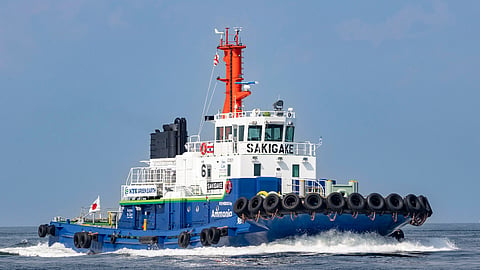VESSEL REVIEW | Sakigake – Japan's NYK places ammonia-powered tug into service
Japanese shipping company Nippon Yusen Kabushiki Kaisha (NYK) and IHI Power Systems, in cooperation with ClassNK, have completed construction of a harbour tug powered by ammonia fuel.
NYK claims Sakigake (さきがけ) is the world's first ammonia-fuelled vessel for commercial use. The construction of the tug was a Green Innovation Fund Project initiated in October 2021 under Japan’s New Energy and Industrial Technology Development Organication (NEDO).
Promoting ammonia as an LNG alternative
The aim of the project was to develop vessels equipped with domestically produced engines that can operate on ammonia. Through the project, NYK also hoped to demonstrate that tugs that operate on ammonia or any other future low-emission fuel will be at least as safe and as capable as their conventionally-powered counterparts.
The NK-classed Sakigake bears the name of an earlier tug that was completed in August 2015 as the first LNG-fuelled vessel in operation in Japan. After eight years of operating in Tokyo Bay, the first Sakigake underwent conversion to enable operation on ammonia fuel.
The newer Sakigake has a length of 37.2 metres (122 feet), a beam of 10.2 metres (33.5 feet), a depth of 4.4 metres (14 feet), and a gross tonnage of 278. The electronics suite includes a Furuno radar.
Sakigake was selected by NYK to operate on ammonia fuel from the outset due to its significantly low CO2 emissions, its higher vaporisation temperature (which makes it easier to handle compared to LNG), and NYK’s own expertise in production and transport of ammonia worldwide.
Safety-centric layout
Due to the inherent toxicity of ammonia, the tug’s hull is laid out in such a way that the crew spaces are placed as far away as possible from the compartments that house the ammonia machinery. Other key features include ventilation systems and double pipes to prevent diffusion in the event of a leak. The design work that went into the tug also emphasised ease of maintenance of the ammonia machinery.
The propulsion system is dual-fuel capable and can also run on conventional heavy oil as an alternative, though heavy oil can also be used even when ammonia is the main fuel. When ammonia is used, the liquefied ammonia in the fuel tank is vaporised, but since the gas cannot self-ignite, combustion is performed by using a device called a common rail system that injects a small amount of heavy oil as an ignition source.
Shin-Nippon Kaiyosha Corporation, a company under the NYK Group, will employ Sakigake in Tokyo Bay during a demonstration period lasting three months to prepare the tug for entry into regular service.


